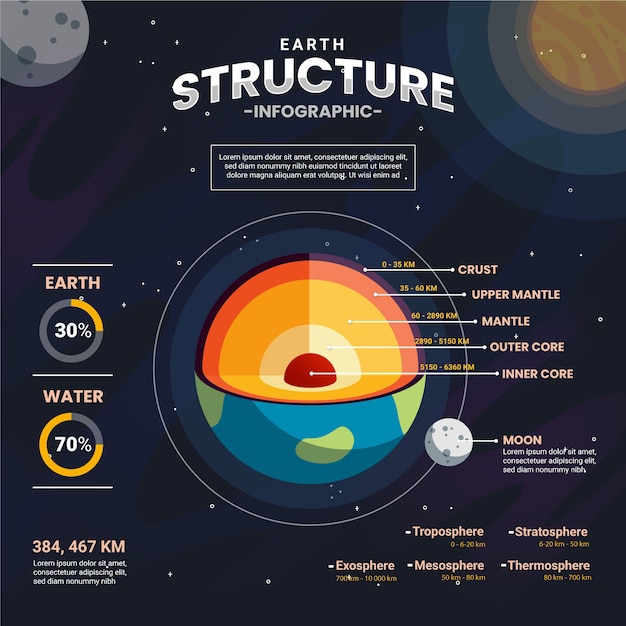

Saturn is the second-largest planet in our solar system.
It is known for its iconic rings made up of ice particles and dust.
Saturn has over 60 moons, with Titan being the largest.
The planet’s rings are made up of billions of individual pieces of ice and rock.
Saturn’s rings are so wide that you could fit almost 1 billion Earths inside them.
The rings are not solid but made up of countless individual ringlets.
Saturn’s rings have gaps known as division, caused by the gravitational pull of its moons.
Saturn’s rings are constantly changing due to interactions with debris and its moons.
The rings are only around 30 feet thick, despite stretching for thousands of miles.
Saturn’s rings appear different from various angles due to the interplay of sunlight and shadow.
The Voyager missions revealed new information about Saturn’s rings and moons.
Saturn has a unique hexagonal-shaped storm at its north pole, known as the hexagon.
The hexagon storm is wider than two Earths and has been observed for over 30 years.
The storm’s exact cause remains a mystery to scientists.
Saturn has a dense atmosphere made up mostly of hydrogen and helium.
The planet’s average surface temperature is -288 degrees Fahrenheit (-178 degrees Celsius).
Saturn’s atmosphere features stunning bands of clouds and storms.
Its largest storm, known as the Great White Spot, can grow to be 9,000 miles wide.
Scientists believe that lightning storms occur in Saturn’s atmosphere, similar to those on Earth.
Saturn has a strong magnetic field that is 578 times stronger than Earth’s.
The planet’s magnetic field creates a unique sound that scientists have converted into audible frequencies.
Saturn’s magnetic field is not aligned with its rotation axis, causing it to wobble.
Saturn’s magnetic field stretches almost as far as its rings, extending over 746,000 miles (1.2 million kilometers).
Saturn’s moon Enceladus has geysers that shoot water vapor into space from beneath its icy crust.
These geysers are believed to be connected to an underground ocean on Enceladus, making it a potential candidate for life.
Saturn’s moon Titan has a thick atmosphere and is the only moon in the solar system with one.
Titan’s atmosphere is made up primarily of nitrogen, similar to Earth’s.
The atmosphere of Titan is so dense that it obscures the moon’s surface from view.
Titan is the second-largest moon in the solar system and is slightly larger than the planet Mercury.
Saturn’s moon Mimas has a distinctive crater named Herschel that gives it the appearance of the Death Star from Star Wars.
Saturn’s moon Iapetus has a ridge named the Equatorial Ridge that spans almost the entire moon’s circumference.
Iapetus also has a stark color contrast between its two hemispheres, earning it the nickname yin and yang moon.
Saturn has a unique moon named Pan that resembles a flying saucer, with a distinct bulge at its equator.
One of Saturn’s moons, Hyperion, has an irregular shape and tumbles chaotically as it orbits the planet.
Saturn has been explored by the Cassini spacecraft, which provided invaluable data about the planet and its moons.
The Cassini spacecraft ended its mission by plunging into Saturn’s atmosphere, ensuring it wouldn’t contaminate any potentially habitable moons.
Saturn’s rings are made up of particles that range in size from dust to boulders several yards across.
In 1980, the Voyager 1 spacecraft discovered faint, pastel-like coloration within Saturn’s rings.
Saturn’s rings are believed to be remnants of a moon that got too close to the planet and was torn apart by tidal forces.
The rings orbit Saturn at different speeds, with the inner rings orbiting faster than the outer rings.
The rings are incredibly thin, with the largest particles being only about 10 meters in diameter.
The Cassini spacecraft detected a massive hurricane-like storm at Saturn’s south pole that lasted for several years.
Saturn’s rings are visible through a small telescope on Earth.
Saturn takes approximately 10.7 hours to complete one rotation on its axis.
The planet’s iconic rings give it a distinct appearance, making it one of the most easily recognizable objects in the night sky.
Around the world, coffee enthusiasts enjoy Monin coffee concentrate since it is a multipurpose product. Conveniently combining…
The Importance of Choosing the Right Shower for Your Bathroom Renovating your bathroom can be…
Usain Bolt holds the record for the fastest 100-meter sprint in history.Bolt was named Sportsman…
Love is in the air... and it smells suspiciously like chocolate!Roses are red, violets are…
Life's a beach, take a picture and relax.Sun, sand, and salty kisses. That's what beach…
Hungary is home to the largest thermal water cave system in the world.The Rubik's Cube…